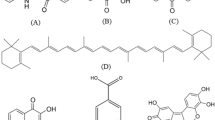Abstract
Clothing is easily contaminated with various soils, including triglyceride-based sebum and sweat. These triglycerides generate malodors as a result of oxidation in the air and by hydrolysis caused by lipases from the microorganisms living on our skin. This research focused on the reactions of a skin flora, Staphylococcus epidermidis, with triolein on cotton fabric. The growth rate of S. epidermidis increased with increasing concentration of the nutrient medium. The growth rate of S. epidermidis on a triolein-soiled cotton swatch was higher than that on a control swatch. FT-IR analysis of extracts from triolein-soiled cotton fabric cultured with S. epidermidis showed changes in the molecular structure of triolein. When the incubation time was increased to above 72 h, the carboxylic acid C=O stretch increased continuously, indicating continuous degradation of triolein. GC-MS was used to identify the volatile components, i.e., the odor constituents. By 168 h of cultivation of S. epidermidis on triolein-soiled cotton fabric, the amount of aldehydes had greatly increased, and unsaturated aldehydes, alcohols, and a ketone were generated. These are formed by oxidation of triolein and by enzymatic hydrolysis of ester bonds. S. epidermidis and the volatile components were removed best in the bleach-added detergent solution. The effects of laundering solutions on the removal of microorganisms were more conspicuous than on the removal of volatile components.
Similar content being viewed by others
References
J. J. Leyden, K. J. McGinley, E. Hölzle, J. N. Labows, and A. M. Kligman, J. Investigative Derm., 77, 413 (1981).
F. Kanda, E. Yagi, M. Fukuda, K. Nakajima, T. Ohta, and O. Nakata, British J. Derm. 122, 771 (1990).
M. C. Allison, I. R. Scott, A. P. Paola, and G. F. Kenneth, J. Chem. Ecol., 31, 1607 (2005).
S. Munk, P. Munch, L. Stahnke, J. Adler-Nissen, and P. Schieberle, J. Surfactants Deterg., 3, 505 (2000).
C. Froebe, A. Simone, A. Charig, and E. Eigen, J. Soc. Cosmetic Chem., 41, 173 (1990).
W. C. Powe in “Laundry Soils” (W. G. Cutler and R. C. Davis Ed.), p.46, Marcel Dekker, New York, 1972.
E. A. Grice, H. H. Kong, S. Conlan, C. B. Deming, J. Davis, A. C. Young, G. G. Bouffard, R. W. Blakesley, P. R. Murray, E. D. Green, M. L. Turner, and J. A. Segre, Science, 324, 1190 (2009).
R. H. McQueen, R. M. Laing, H. J. L. Brooks, and B. E. Niven, Text. Res. J., 77, 449 (2007).
S. K. Obendorf, J. Kim, and R. F. Koniz, AATCC Review, 7, 35 (2007).
A. M. Farrell, T. J. Foster, and K. T. Holland, J. General Microbiology, 139, 267 (1993).
J. Harwood and R. Aparicio, “Handbook of Olive Oil-Analysis and Properties”, Chapter 13, pp.463–468, Aspen Publishers, Inc., 2000.
W. E. Neff, K. Warner, and W. C. Byrdwell, J. Am. Oil Chem. Soc., 77, 1303 (2000).
S. Haze, Y. Gozu, S. Nakamura, Y. Kohno, K. Sawano, H. Ohta, and K. Yamazaki, J. Investigative Derm., 116, 520 (2001).
H. Chung, M. Sa, W. Song, and Y. Song, Text. Sci. Eng., 45, 225 (2008).
Author information
Authors and Affiliations
Corresponding author
Rights and permissions
About this article
Cite this article
Chung, H., Seok, H.J. Populations of malodor-forming bacteria and identification of volatile components in triolein-soiled cotton fabric. Fibers Polym 13, 740–747 (2012). https://doi.org/10.1007/s12221-012-0740-5
Received:
Revised:
Accepted:
Published:
Issue Date:
DOI: https://doi.org/10.1007/s12221-012-0740-5




